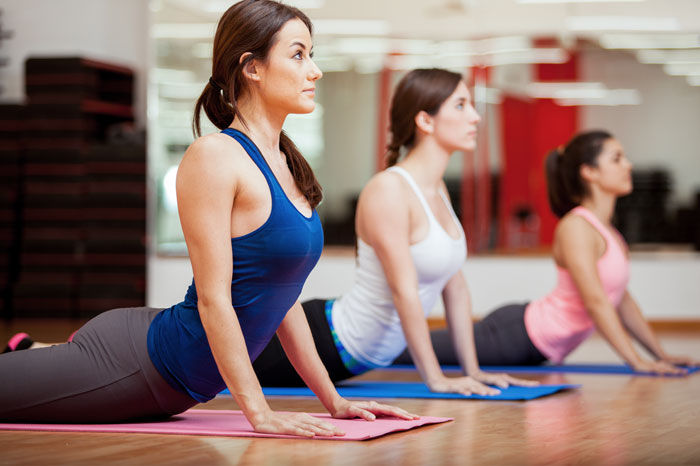
If you love group fitness classes you’re probably already familiar with some of the golden rules of being a good student, such as arriving to class on-time and putting your equipment away when you’re done. However, there are some additional considerations that will help you maximize your results. Four of the country’s top group fitness instructors share the mistakes they commonly see students make in different group fitness classes and offer tips to help you get more out of your next sweat session.
Aquatic Fitness
The mistake: Going in too deep
One of the great benefits that a shallow water aquatic fitness class offers is a joint-friendly fitness experience. However, positioning your body too deeply in the water can actually lead to a less effective workout, shares Stephanie Thielen, certified aquatic instructor and training specialist with the Aquatic Exercise Association. “It’s very common to see participants in the water at shoulder depth. A body immersed to the waist bears approximately 50 percent of its bodyweight, whereas a body immersed to the chest bears approximately 25 to 35 percent of its bodyweight.” The downside to performing exercises at shoulder depth is that the body cannot maintain vertical alignment, which means the strength-based benefits begin to diminish.
The fix: Thielen recommends positioning yourself in waist- to chest-deep water to maximize effectiveness. “This will help to ensure you have control and strength to perform exercises at a moderate pace and that the buoyancy properties of the water do not take over, allowing you to experience the muscular strength benefits aquatic exercise classes offer.”
Yoga
The mistake: Waiting for instructions to become mindful
With a plethora of research-supported physiological and psychological benefits of mind-body exercise formats like yoga, it’s clear that there is much to be gained from a class experience. However, don’t wait for an invitation from the instructor to become more mindful or depend on mirrors to see where you are, urges Lawrence Biscontini, mindful movement specialist and award-winning international fitness educator based in Mykonos, Greece.
The fix: To get more out of the time spent on your mat, Biscontini recommends practicing closing your eyes at will throughout your yoga practice to heighten your own kinesthetic sense, without the need to wait for instructions to do so. “This improves balance, helps you to ‘work in’ and overall increases your self-awareness in time and space, enabling you to know where you are by feeling where you are instead of seeing where you are. This is one of the true goals of mindful disciplines.”
CrossFit
The mistake: Assuming the only approach to warming up is the one the instructor provides
Just as there is not a one-size fits all approach to exercise, there’s also no such thing as a perfect warm-up for all class participants, especially when it comes to CrossFit. While much thought and consideration goes into designing a warm-up for a WOD, it’s important that individuals spend time working to address their own personal needs, says Sabrena Merrill, ACE master trainer and CrossFit coach in Kansas City, Mo. “While I try to address everyone’s needs in a warm-up, some participants might need to take care and spend more time mobilizing an area than what is allotted for. In these instances, I want participants to not always do exactly what I say in the warm-up and instead modify the warm-up and spend time addressing their individual needs.”
The fix: Don’t feel obligated to follow the coach’s warm-up exactly. Instead, Merrill recommends respecting your uniqueness and approaching the warm-up—and the entire WOD for that matter—accordingly, as doing so will help to ensure a safe and effective CrossFit experience. “For example, someone with stiff ankles might need to spend more time foam rolling and stretching their calves. If that means the participant spends less time on the other mobility exercises that are programmed in the warm-up, then so be it.”
Indoor Cycling
The mistake: Pedaling too quickly without enough resistance
One of the most common mistakes people make when in the saddle is pedaling too fast with little-to-no resistance. Many people opt to ride without resistance because they mistakenly believe that too much resistance will result in big, bulky legs, which is completely untrue, according to Keli Roberts, Schwinn indoor cycling master trainer and competitive cyclist. “Riding with adequate resistance produces a higher level of wattage, and because wattage is most closely paralleled with caloric expenditure, adding resistance can help make your legs smaller, stronger and more well-defined.”
The fix: To maximize the benefits of this class format, Roberts recommends pedaling between 70 and 100 RPMs (revolutions per minute)—which equates to how many times one of your legs makes a complete pedal cycle per minute—using adequate resistance. “By using appropriate resistance you increase the wattage,” explains Roberts, “meaning you’ll burn more total calories.”




 by
by 






